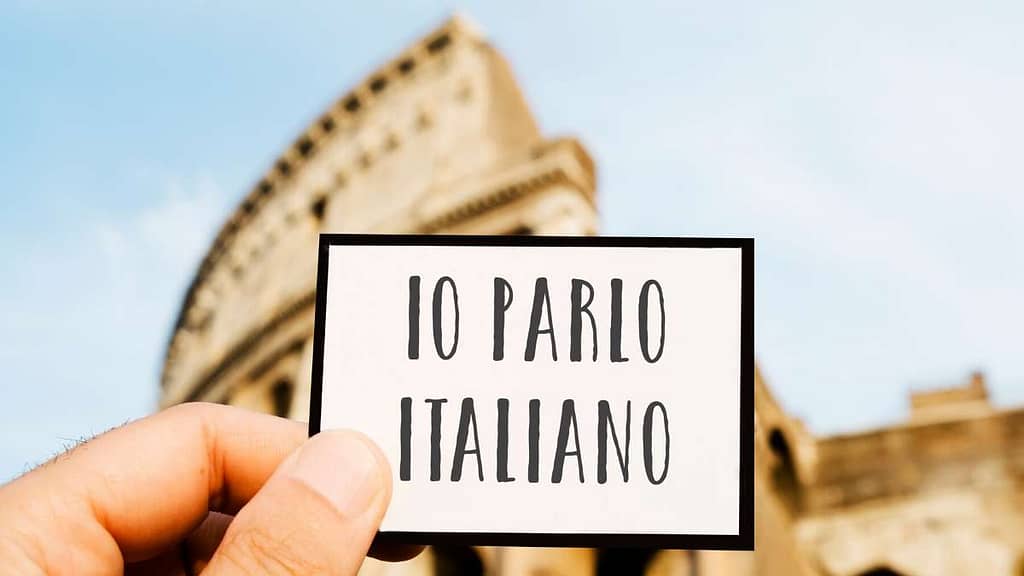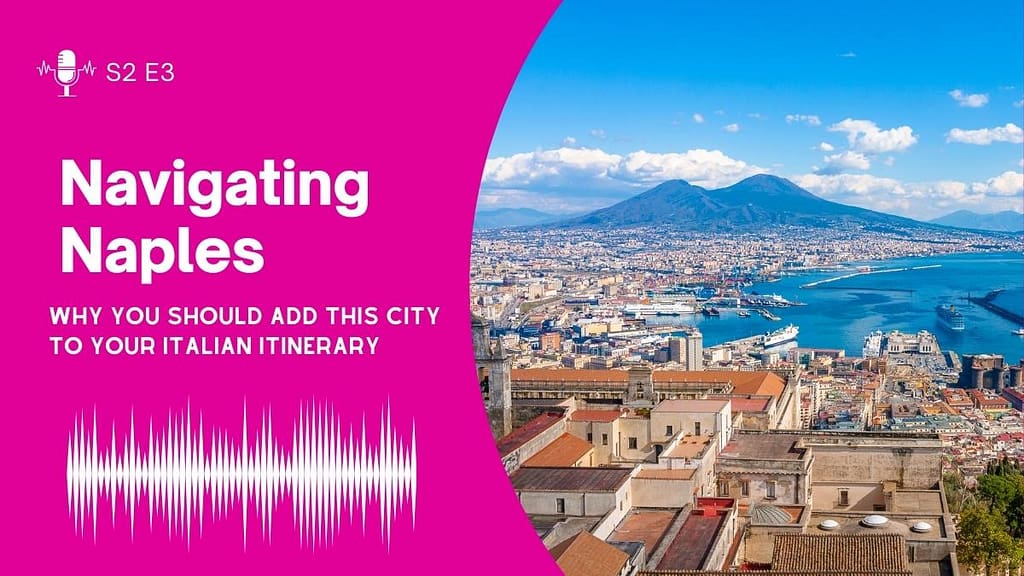In this episode, we explore the stunning beauty of Venice, Italy’s magical water city. Venice is a popular tourist destination that attracts thousands of visitors each day. It is unlike any other place in the world, and it hasn’t changed much over the centuries. How you experience Venice will impact how you feel about this city.
We’re here to share our tips for making the most of your visit because, in our opinion, Venice is magical, and everyone should experience it at least once. So, if you plan to visit on your next trip to Italy and need a Venice guide, then this episode is for you.
Overrated or underrated?
Recently, someone on TikTok shared their opinion on the most overrated and underrated places in Italy. According to them, Venice is an overrated place that they recommend skipping. We wholeheartedly disagree. However, it’s easy to see why someone might not get the best impression of Venice.
Imagine being in an overcrowded amusement park that you have to share with thousands of others. There is only so much space for everyone to fit in, it might be hard to navigate, and since it’s Italy, it can get quite hot.

According to the stats, approximately 110,000 tourists visit Venice each day. That’s a lot of people. Many of them are part of the “hit and run tourism” phenomenon, meaning they come for a few hours and leave. If you happen to be one of those tourists or happen to be in Venice when a cruise ship comes to town, you’re likely not going to like it.
With so many tourists flocking to Venice every day, it’s taking a toll on the already fragile ecosystem. What the average visitor might not know is that there is a massive race against time to keep Venice afloat. Its precarious foundations also mean that Venice might one day disappear. This reason is also why you should visit at least once before it’s gone.
How was Venice built?
Venice started as a fishing village. After the fall of the Roman Empire, many people fled to the lagoon to escape the invading northern barbarian tribes that were pillaging the mainland. What seemed like an unlikely quest became a feat of engineering and an architectural marvel we see today.

Venice was built on the water. Instead of concrete or stone, its base is made of millions of wooden poles. These poles, driven deep into the lagoon’s mud, provided a stable platform for the city to rise. Canals, another vital part of Venice, served a dual purpose. They were essential for transportation, weaving through the city like veins. But they also played a role in construction, solidifying the many small islands into a cohesive whole. Buildings were constructed on top of these platforms, creating a visually stunning and eminently walkable (or should we say, floatable) city.
This ingenious building method wasn’t just about aesthetics. By building on the water, the Venetians cleverly created a natural defence system during a tumultuous time. Surrounded by water, Venice was a safe haven from invaders. But the benefits went beyond just defence. Venice’s watery embrace also made it a perfect hub for trade. The city flourished as a maritime power for centuries, controlling trade routes and building a vast empire.

The Venetians likely chose this location for its defensive advantages. Surrounded by water, the city acted as a natural fortress during the fall of the Roman Empire. However, the watery embrace also propelled Venice to become a significant trading power. Venice thrived as a maritime hub for centuries, controlling trade routes and building a vast empire. Even today, engineers marvel at the ingenuity behind Venice’s construction. The city’s very existence is a testament to the skill and foresight of its builders.
A historical and cultural perspective
Over time, Venice evolved into a military, trading and financial powerhouse. The Venetians were skilled warship makers and astute traders. This made them wealthy and prosperous. It was an international financial and commercial centre for centuries. Goods like silks, grain, spices and art were shipped all over the Mediterranean. It was also a thoroughfare for the Crusades.

Venice’s decline started sometime during the 15th century. Several unsuccessful military campaigns, the discovery of new trade routes by the Portuguese explorer Vasco da Gama, and the devastation of numerous plagues all contributed to its fall. Venice lost its independence to Napoleon in 1797. It then changed hands a few times between Napoleon and the Austrian Empire until it became part of the Kingdom of Italy in 1866.
Venice guide to architectural marvels
Over a million tree stumps pounded into the mud and clay holding up Italy’s water city. It’s hard to imagine how any building can remain here without sinking. Yet, the whole city managed to stay afloat for centuries. Grand palaces, churches, bridges and gardens add to the artistic flair of Venice. Rising seamlessly out of the water, they are a testament to human determination, power and imagination.

As a significant trading power, Venetians had contact with other great cultures of the day. They also had money to spend. Because of that, many of Venice’s architectural elements are a blend of Byzantine, Islamic and Gothic styles. Even the bridges are artfully designed to fit the aesthetic.

Over the centuries, Venetians built magnificent mansions, churches and monuments, adopting new styles to suit their needs. As a result, the architecture in Venice is unlike any other place. One of my favourite things to do here is to wander the little streets and discover beautiful gems that appear on every corner. As many of the buildings were built top-heavy, it’s important to look up. You never know what you will discover.
Top places most people see when they visit:
- St. Mark’s Basilica (Basilica di San Marco): A stunning example of Byzantine architecture, St. Mark’s Basilica is adorned with mosaics, golden ceilings, and opulent decorations. It’s one of the most iconic landmarks in Venice.
- Doge’s Palace (Palazzo Ducale): Once the seat of Venetian power, the Doge’s Palace is a Gothic masterpiece. Explore its opulent chambers, grand halls, and notorious Bridge of Sighs.
- Grand Canal: The Grand Canal is the main waterway of Venice, lined with stunning palaces, churches, and vibrant buildings. Take a gondola ride or simply admire the views from one of the many bridges.
- St. Mark’s Square (Piazza San Marco): The lively Piazza San Marco is the heart of Venice. Filled with pigeons, cafes, and street performers, it’s a great place to soak up the atmosphere.
- Rialto Bridge (Ponte di Rialto): The oldest bridge spanning the Grand Canal, the Rialto Bridge is a must-see for any visitor to Venice. Explore the bustling shops that line the bridge.
- Islands of Venice: Beyond the main island, Venice is made up of many smaller islands, each with its own unique charm. Explore Murano, famous for its glassblowing; Burano, known for its colourful houses; and Torcello, a peaceful island with a historic cathedral.
Navigating Venice: practical tips for visitors
Keep in mind that 90% of those who visit stay in the central zone only. The moment you step away from the main tourist spots, the more likely you are to discover the real Venice. Getting lost in the narrow streets, walking over small bridges, and founding old piazzas and hidden courtyards are what exploring Venice is all about. As you wonder the endless bridges and canals, you’re walking on the same paths as others have done for centuries.

To have a better experience, visit off season. We recommend spring or fall as the best times visit. If you visit during the high-season (July-August) you’ll not likely to have an enjoyable experience. Italian summers get very hot. Add in the crowds and you have yourself a recipe for a less than satisfactory experience.
As most people come to Venice as a day trip, or simply for a few hours, you have a better chance of exploring the city early in the morning or in the evening when the crowds have gone. To do that, we recommend staying in the heart of Venice. Part of the magic is beind able to see the canals and the lovely architecture at dusk.
New Venice guidelines
Starting on April 25, 2024, all day visitors coming to Venice over the age of 14 have to pay a €5 entry fee. The fees are meant to combat overtourism and are set during the peak times. Expect to pay between each weekend in May and June, as well as the first two weeks in July. The fee will be in effect between 8:30 am and 4 pm. Visit the official site for detailed info and to get your ticket.
Venice guide to food
Besides its moniker as Italy’s water city, Venice is a foodie paradise. From creamed cod (Baccala mantecato), squid ink pasta (spaghetti al nero di sepia) and all kinds of seafood, you’ll find a great variety of local specialties to explore.
As Venice has become a city that caters to tourists, pretty much all restaurants will be touristy. That doesn’t mean that you won’t find good restaurants for reasonable prices. Expect to pay more in popular tourist spots and places by canals, especially the Grand Canal. It’s worth wandering into the little streets.
We had some amazing food in Venice. Just thinking about the flavours makes my mouth water. I tried the squid ink pasta, which I wasn’t originally too keen on trying. It ended up being one of my favourite dishes.
The tasty squid tangled in the dark noodles with hints of pesto and tomatoes was outstanding. As was the tuna appetizer done three different ways. Even the bread was tasty. We had other kinds of pasta, gelato and bread, all hitting culinary perfection.
You’ll find an Italian version of tapas called Cicchetti and several Italian-style fast food joints that serve freshly made pasta with toppings in small takeaway containers. For a few Euros, you can grab great quality food and enjoy it as you go. Just make sure not to litter and dispose of your trash appropriately.
10 Facts you might not know about Italy’s water city
- Venice has 417 bridges, including 72 private ones
- There are 177 canals in Venice, with the Grand Canal being the largest
- There are 170 houses along the Grand Canal, built between 1200 and 1700
- Venice was built approximately 1500 years ago and sits on top of long wooden stilts driven down through layers of sand and mud into the compressed clay below
- Italy’s other maritime power Genoa often fought Venice for control of the trading routes
- Venice is made up of 118 islands
- Venice is home to more than 450 palaces
- The city sinks about 1 to 2 millimetres each year
- There are about 350 gondolas in Venice, each measuring 11 meters long and weighing around 600 kg.
- Over the last 50 years, Venice’s population has decreased from 120,000 to 60,000 and is continuing to decline.




